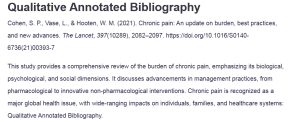Qualitative Annotated Bibliography
Cohen, S. P., Vase, L., & Hooten, W. M. (2021). Chronic pain: An update on burden, best practices, and new advances. The Lancet, 397(10289), 2082–2097. https://doi.org/10.1016/S0140-6736(21)00393-7
This study provides a comprehensive review of the burden of chronic pain, emphasizing its biological, psychological, and social dimensions. It discusses advancements in management practices, from pharmacological to innovative non-pharmacological interventions. Chronic pain is recognized as a major global health issue, with wide-ranging impacts on individuals, families, and healthcare systems: Qualitative Annotated Bibliography.
This research involved a review of the current literature, clinical practice, and new interventions done by the researchers reviewing the multimodal therapeutic approaches of pain management. They appraised treatments, including opioids, cognitive behavioral therapy, physiotherapy, neurostimulation, and telerehabilitation. This work also considers the use of precision medicine and patient Information in improving the long-term outcomes.
The results accent the need for an interdisciplinary approach that would combine conventional and novel treatments. Stress is laid on individual patient care, less use of opioids, and any potential care deficiencies. Studies involving current techniques, such as the use of virtual reality and individualized medicine in the management of chronic pain, indicate great potential in this field, making the work a handy tool for healthcare practitioners.
The use of literature in the study brings about biases, for example, in the kind of practices that are relatively higher in one region than the other and do not factor in several vulnerable groups. Further, the discussion of the long-term effect on health and other issues, such as cost implication and availability, is almost negligible due to the applicability of the study, mostly in resource-restricted populations.
The authors conclude that to enhance chronic pain outcomes, the focus should be given to effective, patient-orientated interventions. They suggest such innovations as new technologies, interdisciplinary approaches, and educational activities to be implemented into practice to improve patients’ satisfaction and their quality of life.
Cohen et al.’s (2021) research is relevant to chronic pain management as it empowers nursing professionals with an understanding of emerging treatments and approaches toward the management of chronic pain. Notably, nursing is keen on the vital part that nurses have in engaging clients in a more patient-centered approach that leads to sustainable positive results.
Rikard, S. M. (2023). Chronic pain among adults — United States, 2019–2021. MMWR. Morbidity and Mortality Weekly Report, 72(15). https://doi.org/10.15585/mmwr.mm7215a1
This report investigates the prevalence of chronic pain in U.S. adults between 2019 and 2021, emphasizing disparities across demographics. Chronic pain significantly impacts individuals’ physical and emotional well-being, productivity, and healthcare use. The study aims to inform targeted healthcare policies and identify at-risk populations for tailored interventions.
Data employed for the analysis of this study were derived from the National Health Interview Survey (NHIS), which included over 30,000 respondents. Stakeholders assessed the rise in chronic pain morbidity and its intensity and frequency across people of different ages, sexes, socioeconomic classes, and geographic regions. The analysis of statistical data showed that there were differences in the share of patients with chronic pain among the population.
The findings estimate that one in three adults live with chronic pain, which prevails in the elderly population, women, and people with lower income or education levels. The study also highlights the problem of disparities in patients of different sexes and ethnicities in chronic pain treatment and the need for preventive interventions. This knowledge is important when developing public health interventions.
The study’s reliance on self-reported survey data introduces potential recall and reporting biases. Moreover, while it outlines various types of chronic pain, it fails to elaborate on the causes of each type as well as exactly how to go about managing or treating patients with such types of pain in different clinical settings.
The authors conclude that chronic pain is still a significant public health issue affecting a range of people with special needs. They call for improved policy on healthcare equality, greater access to efficient pain-relieving techniques, and the encouragement of a strategy to avoid chronic pain conditions and inequalities.
For nursing professionals, this research highlights the importance of addressing demographic disparities in chronic pain management. It provides evidence to guide tailored interventions, advocacy efforts, and policies aimed at improving care for at-risk populations.
References
Cohen, S. P., Vase, L., & Hooten, W. M. (2021). Chronic pain: An update on burden, best practices, and new advances. The Lancet, 397(10289), 2082–2097. https://doi.org/10.1016/S0140-6736(21)00393-7
Rikard, S. M. (2023). Chronic pain among adults — United States, 2019–2021. MMWR. Morbidity and Mortality Weekly Report, 72(15). https://doi.org/10.15585/mmwr.mm7215a1
ORDER A PLAGIARISM-FREE PAPER HERE
We’ll write everything from scratch
Question
Qualitative Annotated Bibliography
For this assignment you will continue to review current research from Online Library and provide a critical evaluation on that research through an annotated bibliography. An annotated bibliography is a brief summary and analysis of the journal article reviewed. For more information on annotated bibliographies please visit Purdue’s OWL: Purdue Online Writing Lab
A total of two annotated bibliographies are to be submitted (not to exceed one page each). The articles must come from nursing scholarly literature and may not be older than 5 years since publication. Please note that the articles must be research based and reflect a qualitative methodology (review our reading assignments).

Qualitative Annotated Bibliography
Web pages, magazines, textbooks, and other books are not acceptable.
Each annotation must address the following critical elements:
• Explanation of the main purpose and scope of the cited work
• Brief description of the research conducted
• Value and significance of the work (e.g., study’s findings, scope of the research project) as a contribution to the subject under consideration
•Possible shortcomings or bias in the work
•Conclusions or observations reached by the author
•Summary as to why this research lends evidence to support the potential problem identified specific to your role specialization

